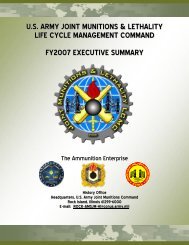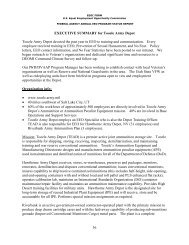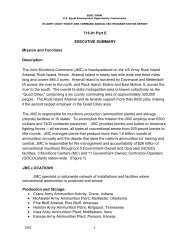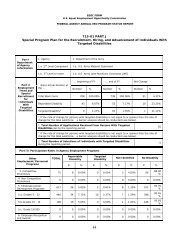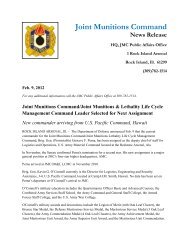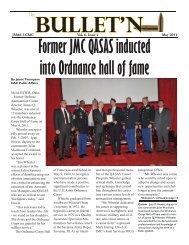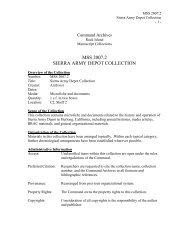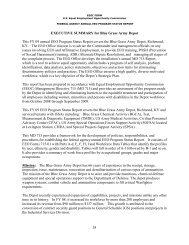History of the Ammunition Industrial Base - JMC - U.S. Army
History of the Ammunition Industrial Base - JMC - U.S. Army
History of the Ammunition Industrial Base - JMC - U.S. Army
Create successful ePaper yourself
Turn your PDF publications into a flip-book with our unique Google optimized e-Paper software.
The computation <strong>of</strong> ammunition requirements was different from o<strong>the</strong>r classes <strong>of</strong><br />
supplies. It ranked high in importance and was sometimes compared to supplying food to <strong>the</strong><br />
troops. <strong>Ammunition</strong> was more complex because <strong>the</strong> rate <strong>of</strong> consumption was irregular.<br />
<strong>Ammunition</strong> requirements were based on day <strong>of</strong> supply estimates, which was <strong>the</strong> average<br />
number <strong>of</strong> rounds that would be expended by each type <strong>of</strong> weapon per day in <strong>the</strong> course <strong>of</strong><br />
planned operations. There were no tables showing <strong>the</strong> number <strong>of</strong> rounds to be issued to any<br />
tactical unit. The rate for each weapon included a breakdown showing <strong>the</strong> estimate for each type<br />
<strong>of</strong> shell, high explosive, armor piercing, incendiary, etc; and for each type <strong>of</strong> fuzes when more<br />
than one type could be used on a shell. For training ammunition, specific quantities per man<br />
were authorized. 90<br />
As planners struggled with <strong>the</strong> best way to predict field requirements, <strong>the</strong>y experimented<br />
by linking equipment production schedules to projected ammunition requirements. For example,<br />
bombs and ammunition for aircraft called for production <strong>of</strong> a five-month supply for each<br />
bomber, based on aircraft production schedules, estimated number <strong>of</strong> sorties a month for each<br />
plane and <strong>the</strong> number <strong>of</strong> bombs dropped and rounds fired per sortie. The computations soon<br />
resulted in over production <strong>of</strong> bombs because all planes did not go immediately from factory to<br />
overseas <strong>the</strong>ater or <strong>the</strong>y didn‟t engage in bombing runs. This resulted in production cuts for<br />
bombs in 1943. Then, as air attacks escalated in 1944, many <strong>of</strong> <strong>the</strong> cuts had to be restored and<br />
production was reinstated. 91<br />
Adding to <strong>the</strong> fluctuation included <strong>the</strong> frequency <strong>of</strong> equipment changes that occurred<br />
1940-1945. For example, <strong>the</strong> number <strong>of</strong> men in just one infantry regiment decreased over <strong>the</strong><br />
course <strong>of</strong> <strong>the</strong> war and its requirements for pistols, trucks and rifles all decreased before 1942 and<br />
increased by 1945. The cumulative effect <strong>of</strong> <strong>the</strong>se changes was enormous and nothing was<br />
static.<br />
At <strong>the</strong> beginning <strong>of</strong> WWII and two years into it, replacement factors for ammunition<br />
were <strong>the</strong> result <strong>of</strong> guesswork. No one conclusively knew how long <strong>Army</strong> equipment would<br />
withstand under combat conditions, nor did anyone have accurate notions <strong>of</strong> how much<br />
ammunition an infantry regiment or field artillery battalion would need. Some historians have<br />
declared that <strong>the</strong> day <strong>of</strong> supply figures used in 1940 and 1941 were defective. The calculations<br />
were too high and didn‟t allow for differences among <strong>the</strong>aters. 92<br />
The Ordnance Department came into WWII relying on Frankford Arsenal for small arms<br />
ammunition, artillery projectiles, cartridge cases, optical and fire control instruments, gages and<br />
pyrotechnics. Picatinny Arsenal focused on artillery ammo, explosions and propellants. While<br />
<strong>the</strong> production capacity was never enough to meet <strong>the</strong> needs <strong>of</strong> wartime demand, each<br />
manufactured specialized ordnance when expansion was needed. Between 1938 and 1941<br />
Frankford‟s small caliber yearly capacity increased from 400 million rounds to 630 million<br />
rounds by increasing shifts and expanding lines. 93<br />
The small arms ammunition base is described to be built in waves throughout WWII.<br />
Total capacity increased to over 41 billion rounds produced at 12 ammunition plants by 1945.<br />
90 Ibid, 53.<br />
91 Ibid, 51-52.<br />
92 Thomson & Mayo, 47-50,<br />
93 Ibid, 188.<br />
31



